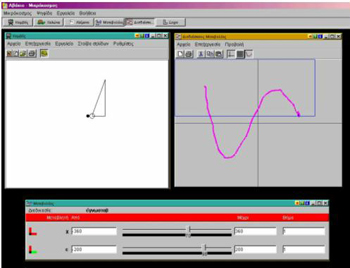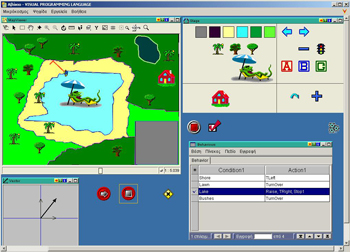ORTHOGONAL TRIANGLE
|
The parametric program that is given to you ask the "turtle" to sketch an orthogonal triangle under certain conditions. This conditions have to do with the values of the two parameters. Can you find out what each parameter represents? Can you find out couple of values for which the figure is an orthogonal trianglel? Can you make conjectures about the relation between these two values? You have the two sliders at your disposal so as to experiment. When you find out the relation between the two values you can "fix" the program so as to always construct an orthogonal parallelogram!!
This activity is appropriate for the students of the second and third grade of high school and the first grade of lyceum. Students are given a half-ready program that constructs the desirable orthogonal triangle only with certain values of its two parameters.
|
 |
 |
| Students can use it so as to experiment and explore the kind of relation between the values of the parameters. The two sliders, the one-dimentional and the bi-dimentional are at their disposal. In this way they can alter the figure dynamically. When they find out the relation they can fix the program and 'breathe life' into the orthogonal triangle observing the periodicity of the angle relations. In the end they can write their own half-made program and give it to their classmates so as to Ďamendí it. |
download


 |
-------------------------------------------------------------------------------------------------
|
COMPUTER GAME DESIGN
|
With the software Ďcomputer game designí you can plan and develop computer games for your classmates! The games have a hero that the player must drive around the. But you can set down your own rules about what is going to happen to the hero when various incidents take place, such as falling in the lake or hitting a tree. Let your classmate then drive the hero from one side to the other!
In 'Computer Game Design' activity students make their own games or modify and improve the games that are made by others, students or teachers. The development of games is based on the composition of rules of conditional form "if this happen, then you make that". In order to compose such rules children have in their disposal a number of
|
 |
 |
| "building blocks" of the form "condition" and a number of "building blocks" of the form "action"(e. g. if you are near the dragon, you turn 180 degrees and run). A group of rules constitute the behaviour of the hero of a game who can interact with other heroes or with the environment. Through planning, developing and playing such games children develop logicomathematical abilities relating to causality, inference, the meaning of conditionality and the process through which a conclusion is drawn. |
download



|